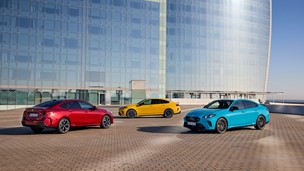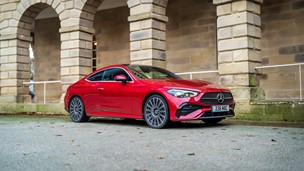The arrival of the 307 CC in the CARkeys holding paddock happened to coincide with the start of some fabulous weather. This wasn't quite as splendid a coincidence as it might have been, since I'm not a great fan of driving around with the roof down and there was now no excuse to avoid doing so.It did mean, though, that I was able to demonstrate to adoring fans the CC's ability to go from Coupé to Convertible with an almost complete lack of effort on the part of the driver. All you have to do is press a switch near the gearlever, and within 22 seconds the roof is now either folded and stacked away, if it wasn't before, or, if it was, isn't.The releasing and folding and removing and uprooting and whirring and so on is all the more enjoyable for the fact that it happens automatically, and more so again for the fact that onlookers think it's so cool. Some of them may even applaud. I dare say this represents a lot of the appeal of 307 CC ownership.Perhaps not as much as the idea of open-air motoring itself, though. Once the opening procedure has been completed you're left with a car with no visible roof and no visible side windows either, these having retracted at some point in the 22 seconds.At this point the CC now looks tremendously sexy, but it's not in the ideal state for maximum comfort at open-road speeds, since the air deflected by the windscreen gets jumbled up something terrible inside the cabin. If personal happiness is more important than personal PR, the thing to do is put the windows up again, thereby making the CC a perfectly practical top-down cruiser.Even with the roof up the CC looks very smart indeed, a point not lost on Peugeot when it decided to switch from the 206 to the 307 for its World Rally Championship campaign. A 307 hatchback rally car, however well it actually performed, would have looked exceptionally ungainly - as far as aesthetics are concerned they might as well have based their WRC car on the SW and be done with it.Instead, Peugeot used the vastly more attractive outer shape (though not the folding roof mechanism) of the CC. The rally car is therefore much prettier than might otherwise have been the case, and in a sort of reverse reference the CC now takes on some of the sporting associations of the rally car.Not that, in the form tested here, it's lacking in those on its own account. The two-litre engine, while dulled slightly by the effect of the extra weight compared with the 206, is still a hearty unit and produces sharp performance even in this application. And Peugeot certainly didn't lose any of its talent for suspension tuning when it started work on the CC. The front end turns into corners very neatly, and stays planted with a little help from the rear, which tries neither to dominate nor to let go. The overall balance is top class, while the ride is a good deal better than in other sporty Peugeots of current and past years. If you've ever driven a 205 GTi or a 206 GTi 180 you'll know whereof I speak.I have to admit at this point that some of the above paragraph is all but based on conjecture. I know that the CC both performs and handles better than I think it does. The reason for this is that, even in the front, it's quite astonishingly cramped for a car of its overall size.I had to move my foot on the throttle pedal if I wanted to get it anywhere near the full extent of its travel, and I couldn't get far enough away from the steering wheel to operate it comfortably without shifting in the seat. This is not a car you can drive properly if you are over six feet tall.And you might have to be no more than half that size in order to sit in the back. There is so little room in there that the CC barely qualifies as a four-seater at all. Luggage space isn't too clever, either, and of course it's compromised severely whenever the boot has to carry the roof.It so happens that while I had this car on test I also drove a Ford Streetka, which is also cramped in the front and has no rear seat whatever. But it did strike me as odd that in terms of practical interior volume they were far more closely matched than their very different body sizes would suggest.Altogether, for a car based on a perfectly sensible hatchback, the CC doesn't make much sense at all as a family car. But if you want one of those you probably wouldn't be paying much attention to the coupé-convertible market in the first place. As a means of elegant transport for stylish singles or cool couples (preferably petite ones) the CC has a lot of appeal.Second opinion: Yes, this is a very stylish car, and it wins over the 206 in having the longer wheelbase without which the smaller car in CC form can't avoid looking rather dumpy. Being rather more perfectly proportioned, perhaps, I didn't find the seating and pedal position cramped, but there's no doubt that this is a car with four full seats which can't be expected to take four adults, because of the lack of rear-seat legroom. Reasonable as a three-seater, though, if whoever sits behind the front seat passenger comes to a compromise arrangement. Running two-up and roof-down, I'd certainly want the extra-cost option of a wind deflector behind the front seats. A car with an open cabin of this area does provoke a certain amount of swirling airflow - although, even without the deflector, it's mostly hair-fluttering and not really excessive. Roof-up, it's worth noting the unusually high-curved rear window, which makes the closed cabin seem airy too. I didn't much like the metal-style thumb grips on the steering wheel - a little naff, I thought. But the drilled aluminium pedals and other items were just right for a car which, as noted above, does keep up Peugeot's reputation for managing a good balance of handling and ride. Ross Finlay. Engine 1997cc, 4cylinders Power 180bhp @7000 rpm Torque 152ib/ft @4750 rpm Transmission 5 speed manual Fuel/CO2 32.1mpg / 210g/km Acceleration 0-62mph: 10sec Top speed 140 mph Price From £20210.00 approx Release date 16/10/2003

Our Rating



